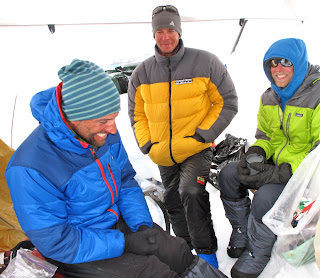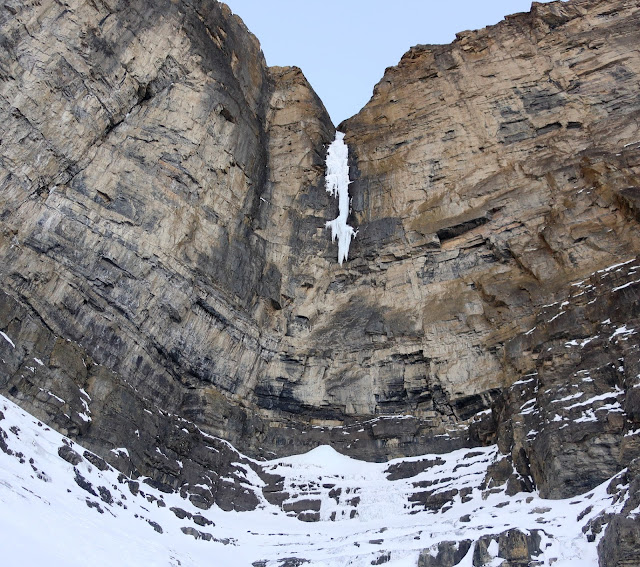Denali: On The Butt
Alaska?
Every spring robins, ducks and geese, driven by an evolutionary imperative, fly north to mate, nest and breed. Alpinists might not be subject to the same reproductive urge. All the same, as days get longer and ice climbs in their home mountain ranges once again become waterfalls, they too feel the pull of the vast boreal tundra, and of the great white peaks rising above it. I seem to go up north every other year or so: I have made trips to the Alaska Range in 2005, 2007, 2010, and again this year. What is it about the place that keeps drawing me back? Is it the huge faces of perfect granite laced with ice, rising above immense glaciers? Is it the 24-hour daylight that throws off your internal clock and lets you – if you are masochistically inclined – to climb for as long as your body and mind will let you? Is it the thin, cold air high on Denali that forces you to tread a fine line, too cold to stop and rest, too exhausted to warm up through movement? I expect it is probably all of that, and something else besides I cannot quite put my finger on. But I intend to keep going back to try to find out.
The great white peaks of the north (Mts Saint Elias and Logan?) from the Vancouver-Anchorage flight.
Plans and strategies
Joshua Lavigne and I planned to spend most of June on Denali, taking advantage of the warmer temperatures that month brings to the upper reaches of the mountain – while also escaping the monsoon that usually deluges the Bow Valley at this time of the year. We had researched several different routes to give ourselves a choice of objectives to suit psych, weather and conditions. It is good to have specific goals in mind to keep one from wasting time and energy. But it is also important to be flexible and to allow the mountain, rather than plans made in one’s living room months beforehand, to determine what to climb. What we were clear on was the style in which we would climb. With its 24-hour daylight, the Alaska Range is uniquely suited to single-push climbing. Over the years people like Mugs Stump, Steve House, Marko Prezelj and many others have shown that any route in the range, no matter how big, can be done with a daypack, a stove, and a willingness to push one’s body and mind beyond preconceived limits.
A midnight sunset over Denali.
Acclimatizing
At 6194 m, Denali is small compared to, say, the mountains of the Karakoram, where 6000-metre peaks are a dime a dozen. But its location just south of the Arctic Circle, due to the flattening of the atmosphere at the poles, means that the air on its summit is quite a bit thinner than it would be at more moderate latitudes. How much thinner? A casual comparison of the air pressure in Alaska and Pakistan indicates that, owing to its northerly latitude, the summit of Denali feels up to 500 metres higher.
Now all of this is a roundabout way of saying that, before launching on single-push missions, one has to acclimatize. Fortunately the normal route on Denali, the popular West Buttress, is perfect for this purpose. Over a number of trips to Alaska and Pakistan (along the way nicely illustrating the saying that “good judgment comes from experience and experience comes from bad judgment”) I have developed some acclimatization strategies that work well. One strategy is to follow the well-known advice of going high but sleeping low. From painful experience, camping high while not acclimatized absolutely sucks. Another strategy is less obvious but just as important, and it is not to fuck around while acclimatizing. I remind myself that for the first bit of a trip, the aim is to acclimatize, not to climb anything interesting; that will come later. Interesting climbing is usually slow and tiring, and as such is not conducive to getting high as efficiently as possible. I wasted a lot of time on my trips to Pakistan trying to make acclimatization interesting before I learned this particular lesson. What all of this means on Denali is taking two or three days getting up to 14k on the West Buttress, setting up a comfortable camp, and then going on daytrips higher up, first to 17k and then to the summit. If all goes well, within a week or so of landing on the glacier one should be ready to “get off The Butt and go climbing,” as Scott Backes once memorably put it.
Josh, still not quite acclimatized, takes the last few steps to the summit of Denali. Mt. Foraker rises over his right shoulder.
Talkeetna
We left Calgary on the morning on June 4th, and by late afternoon arrived in quaint Talkeetna, the jump-off point for most trips to the Alaska Range. This small Alaskan town has a lot of climbing tradition, from the historic Fairview Inn that saw the likes of Dougal Haston and Doug Scott pass through its doors, to the sobering sight of the climbers’ cemetery, with its grave markers made of rusted ice tools. That evening we caught up with some friends over what would be our last beers in a while. The following morning we received our Clean Mountain Can, that Denali climber’s essential (though seriously now, the rangers have done an amazing job of ensuring the mountain does stay clean). After waiting for a few hours for the weather to clear, we piled into one of TAT’s Beavers and headed for the hills.
Talkeetna spring.
A motley crew gathers at the West Rib pub. Photo: Eric Landmann.
A grave marker at the Talkeetna climbers' cemetery.
The TAT cat prowls the airstrip.
Under a ceiling of low cloud we followed the frozen river of the Kahiltna Glacier upstream. The giant bulk of Mt. Foraker loomed to our left, and then we were banking sharply right and coming in to land below the north face of Mt. Hunter, guessed at more than seen though the clouds. The usual choreographed pandemonium greeted us on the landing strip: the dazed new arrivals dragging their duffels up the hill, while others, eager to be off of the mountain, dragging theirs down.
The Susitna River near Talkeetna.
The terminus of the mighty Kahiltna Glacier.
Glacier textures.
The West Butt
The following morning we were away early to take advantage of the cold for easier travel. The skies had cleared overnight, and while we skied along in the blue shadows on the valley bottom, the summits glowed yellow in the morning sun. The sun did eventually catch us at the bottom of Ski Hill, where the West Buttress route, after a long stretch of almost horizontal glacier travel, begins its circuitous ascent. For some perverse reason we were determined to make it all the way to the 11k camp, so we sweated our way uphill, with our heavily loaded sleds as our ball and chain.
We spent an unexpected two days at 11k, while I recovered from a nasty cold, before moving up to 14k. The 14k camp, situated in a sheltered basin nearly two vertical kilometers below the summit of Denali, would be our home for the next two weeks. We gratefully parked our sleds and set up camp, designer kitchen and all, knowing that from here on we would not have to carry anything bigger than daypacks.
Josh, sled in tow, makes his way up Ski Hill, with the West Kahiltna Peak rising behind him.
Weird scenes inside a goldmine (or on a glacier, in this case), as a soloist protects himself creatively against a crevasse fall.
The Big One. The West Buttress follows the left skyline while the Cassin Ridge climbs the right. The West Rib is in the centre; note the serac avalanche in the cirque left of the West Rib.
We spent an unexpected two days at 11k, while I recovered from a nasty cold, before moving up to 14k. The 14k camp, situated in a sheltered basin nearly two vertical kilometers below the summit of Denali, would be our home for the next two weeks. We gratefully parked our sleds and set up camp, designer kitchen and all, knowing that from here on we would not have to carry anything bigger than daypacks.
The 14k camp is not threatened by serac fall. Really!
Josh whips up a high-altitude cappuccino.
The twin-summitted Mt. Hunter from the 14k camp.
After a day’s rest we hiked up to the 17k camp to breathe some thin air. From 14k the normal route climbs a forty-degree headwall adorned with fat fixed ropes, before turning right and following the easy but spectacular crest of the West Buttress. During the daily rush the fixed ropes can be a surreal experience, with traffic jams and flaring tempers worthy of Calgary or Chicago. Just as on a divided freeway, here too there are designated up and down-lines. Most people climbing Denali box themselves into fixed ways of doing things: they carry huge loads, they cache them, they go back down and bring up more stuff, they jumar up what would be a black ski run back home. It does not occur to them to experience the joy of unencumbered movement for a change: to ditch the big back, to simply walk up beside the fixed lines, to bypass the entire circus. I hope they are having fun, though I am not sure how much fun walking crushed under a monstrous pack, all the while staring at the heels of the person in front of you, can be.
Josh carrying his skis up the headwall above the 14k camp. He skied down the icy Rescue Gully from the 17k camp in his soft climbing boots, a "terrifying descent."
The crest of the West Buttress at around 5000 m.
A busy day on the fixed ropes. Note the up-line on the right and the down-line on the left.
A snowy day at 14k.
"More strawberry syrup on your pancake?"
From the left: Martin, Josh and Yann tackling the world's problems.
After another day’s rest we hiked up to the summit. My cold had turned into a sinus infection (many thanks to our 14k-camp neighbour and fellow Calgary alpinist, Dr. Jasmin Fauteux, for salvaging our trip with his antibiotics!), and for the first couple of hours out of camp I felt like shit. My heart was pounding, I was pouring sweat and I moved at half the pace I should have. But strangely, the higher we went the stronger I felt, and in the end I was able to push my burning lungs and aching legs up the final ridge to the top. A week and a day had passed since we landed on the glacier, and we could finally go climbing.
Josh on the Autobahn, the thirty-degree traverse to Denali Pass above the 17k camp.
A tiny figure emerges onto Denali's summit ridge.
The air pressure on the summit is well below half of that at sea level. And no, though it was relatively warm that evening, it was certainly not +22 C.
Breathless but happy on top.
(to be continued)
We would like to thank the Mountain Equipment Coop for its generous support of our trip. Both Josh and I are long-time MEC members, which made its backing all the more meaningful.
We would like to thank the Mountain Equipment Coop for its generous support of our trip. Both Josh and I are long-time MEC members, which made its backing all the more meaningful.





























Good
ReplyDelete